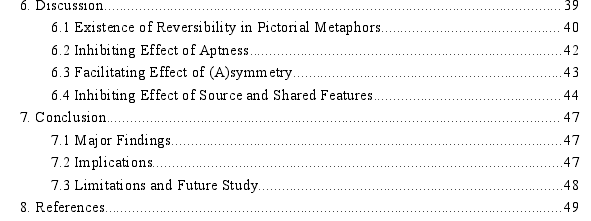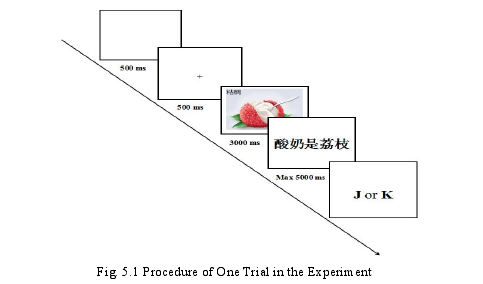语言学论文哪里有?本研究最重要的贡献在于发现,尽管反向隐喻和正向隐喻的理解存在差异,但可逆性确实存在于隐喻理解中,这意味着可逆性只在条件下发生。与CMT认为隐喻中两个域之间的映射是基于单向投射的观点相比,本研究指出,对于图像隐喻而言,两个域概念之间的双向关联可能是隐喻形成和理解的初始阶段,在单向投射之前。这种时间优势可以用图像优势效应来解释,它为超视距解释提供了更广泛、更快的可能性。实验中使用的句法标记也可以解释这个结果。
1.Introduction
1.2 Research Objectives and Significance
In the research of pictorial metaphors, a metaphor, academically defined, alwayscompares two different objects: one is the target object and the other is the source object.From the practical perspective, viewers depend on shared information to yield positive effectssuch as purchase desires. One of the premises to achieve this expected intention is improvingviewers’ comprehension and liking towards the advertisements to trigger viewers’ interest sothat they may exchange active interpretations after being exposed to the advertisements. Thisassumption has led scholars to study such issues as how viewers identify and confirm thetarget objects, what factors will influence the choice, the extent to which they appreciateadvertising and how they can compromise a balance between advertisement comprehensionand advertisement liking.
In order to clarify the comprehension processing mechanism, several factors whichinfluence the outcomes have been identified. Among the diverse influencing factors for theprocessing of advertising pictorial metaphors, individual comprehension, aptness, familiarity,involvement, visual structure of pictorial metaphor, verbal clues, and (a)symmetry are themost important.Based on all the above, this paper aims to study the reversibility in the processing ofpictorial metaphors by observing the influencing factors of aptness, (a)symmetry, and verbalfeatures, with other factors controlled. Three research questions will be answered:
(1) Does there exist the reversed processing of pictorial metaphors? (Experiment One,with a focus on aptness)
(2) In real advertisement context, given comprehension and advertisement liking, whatis the effect of (a)symmetry on reversibility? (Experiment Two, with a focus on (a)symmetry)
(3) What is the effect of verbal clues on reversibility in real advertisement context?(Experiment Three, with a focus on verbally- presented features)

3. Experiment One: Reversibility and Aptness
3.1 Pretests
In pretests, there were three tasks: (1) naming task; (2) rating the aptness and familiarityof the pictorial metaphors; (3) generating verbal features, including target features, sourcefeatures, and shared features separately.
3.1.1 Aptness and Familiarity
The questionnaires were randomly distributed to the students of Dalian University oftechnology. In total, 173 participants took part in this test. All participants, aged 18-25(averaged 23.5), were college students from different disciplines, with bachelors’ degree orhigher.
Two hundred hybrid pictorial metaphors were collected from various print advertisementmedia, for the following reasons. Firstly, pictorial metaphors in print ads have been studiedwidely these years, and many examples are obtainable online. Secondly, print advertisementsare creative with clear information to convey. Thirdly, compared to pictorial metaphors fromother resources such as cartoons, the information carried by print advertisements are usuallysimpler, needing less social and political knowledge for comprehension. After the initialscreening, totally 60 advertising pictures were retained. Given the fact that the participants inthis experiment were college students, the advertising pictures were made sure that theyinvolved the best- selling and low- involvement products, that is, the advertised products inthe pictures should be frequently purchased by college students, including foods andbeverages[101]. In these pictorial metaphors, the logos, slogans, and brand names (if present)were all removed to avoid reading influence[102]. Three pretests were introduced in detail asfollows:
5. Experiment Three: Reversibility and Verbal Features
5.1Participants and Materials
The participants were same as those in Experiment Two.The materials were same as those used in Experiment Two. In addition, for eachadvertisement pictorial metaphor, one target feature, one source feature and one sharedfeature were added to the image respectively (see appendix C). All these features weregenerated and computed from the pretests.

5.2Design
One 2 ((a)symmetry: symmetry vs. asymmetry) X 3 (direction: forward metaphors vs.reversed metaphors vs. neither (a baseline condition)) X 3 (verbal feature: target feature vs.source feature vs. shared feature) within- subject analysis was used.
In this experiment, the experimental paradigm was based on the one by Indurkhya andOjha[10], and the one by Plug[63]. Participants were firstly informed that their task would be towatch various advertisements, and then to judge whether these advertisements could bedescribed by the text that appeared immediately after. The 32 advertisements accompanied bythree questions and three kinds of verbal clues were presented randomly in the center ofscreen. The verbal feature was set on the upper left corner of the pictorial metaphor becausesome studies have shown that in the co-existence of images and texts, it was more likely thatthe subjects saw pictures before seeing words, from the left to the right[62]. In order that theparticipants responded to the text first, in the upper left corner of the picture the highlightedtext was placed.
The procedure is as follows:
Participants were informed that they were going to take part in a behavior experimentrelated to advertisements so that all materials they would see were real advertisements. Eachpicture would appear three times with three different verbal features followed by threedifferent directions of statement randomly, including “A is B”, “B is A”,“Neither ‘A is B’nor ‘B is A’”. Then, after a practicing process, subjects would be familiar with theexperiment’s procedure. Experimental materials were presented by E-prime 2.0 software onthe IBM laptop. All the stimuli were in the center of screen with same size and font.
7. Conclusion
7.1 Major Findings
The most important contribution of the study is the finding that reversibility does exist inmetaphor comprehension, despite a difference of the comprehension between the reversed andforward metaphors, which means that reversibility only occurs conditionally. Compared withthe CMT claiming that the mapping between two domains in a metaphor is based on one-direction projection, this study points out that for pictorial metaphors the bidirectionalassociation between concepts from two domains may be the initial phase of metaphorformation and comprehension, preceding unidirectional projection. This temporal advantagecan be explained by the picture superiority effect that opens a wider and quicker possibility ofmetaphor interpretation. The syntactic marker used in the experiment may also account forthis result.
The second significance of this study lies in that it explored and verified threeinfluencing conditions. First, in terms of the relationship between the target and the source,the aptness of pictorial metaphor influences the reversibility. Pictorial metaphors of highaptness are easier to be comprehended and appreciated compared to those of low aptness. Inaddition, in the real advertising context, (a)symmetry considering how the target- sourceobjects are presented can lead to varied degrees of reversibility. Asymmetrical pictorialmetaphors are less reversible and easier to be processed. At last, from the perspective ofcontextual clues, verbally-presented features also play an important role in reversibility, withsource features and shared features having a more significant effect than target features.
reference(omitted)

